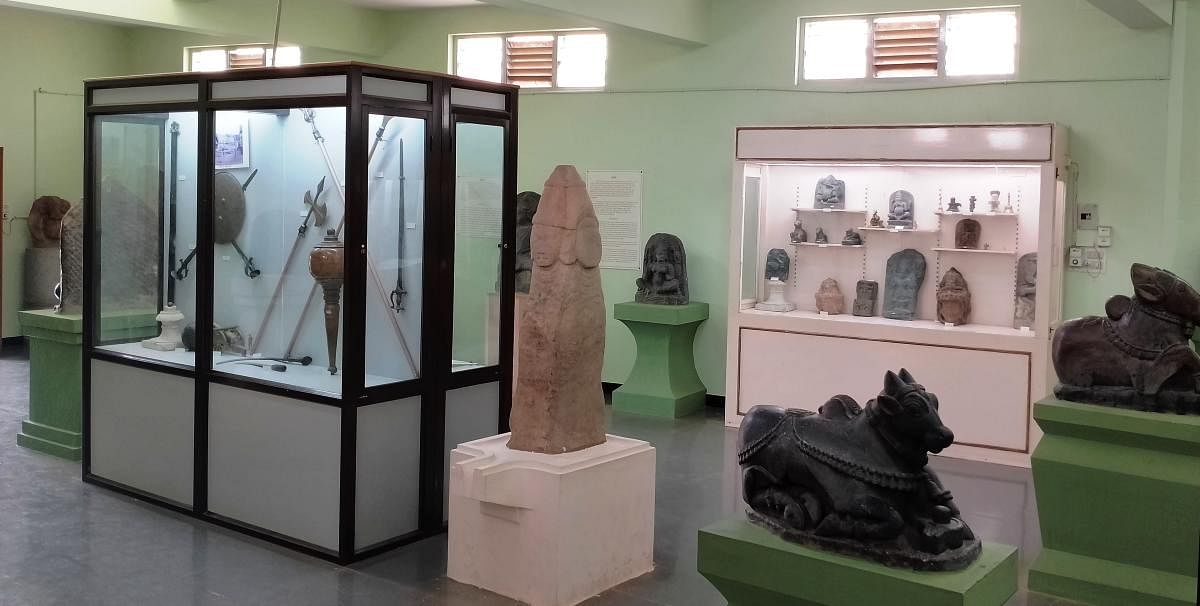Bagalkot's cultural complex






In the newly-established Navanagar, a cultural complex spans a large area, and houses art, culture and administrative offices with a beautiful garden. Navanagar was created after the submergence of parts of old Bagalkot city. The town was originally designed with 63 sectors, spread across 1,521 acres of land, six km away from the old Bagalkot. Most of these sectors were developed to rehabilitate those displaced by the Almatti Dam.
Water from the upper Krishna valley of Bijapur (now Vijayapura) and Bagalkot districts flows into the Ghataprabha and Malaprabha rivers, tributaries of River Krishna.
Bagalkot was separated from Bijapur and formed into a district in 1997.
Bagalkot district is home to rich historical sites such as Badami, Pattadakal, Aihole. The Yadahalli Chinkara Wildlife Sanctuary is located in the Bilagi and Mudhol ranges of the Bagalkot Forest Division.
Nabi Nadaf, a local social activist, took us to the cultural complex in Navanagar where a museum is set up. Having resided here since his childhood, Nadaf explained the history of the place to us.
The museum features a large section on the glory of Bagalkot, with stories told through photography. The pictures have captured various elements including government buildings, schools, colleges, dams, rivers, old monuments, residential colonies and roads. This section is arranged in such a manner that one can learn about the old and new of Bagalkot through panoramic-angle photos.
Ancient artefacts
Moving to the next section, there are a number of rooms filled with ancient artefacts. Jain inscriptions, armories, manuscripts and utensils from the ninth to the 13th century are on display. Sculptures of Mahavir, Parshvanatha, Lajja Gowri, Kaali, Vahana and several other deities are also exhibited, with labels indicating they once belonged to the Rashtrakuta, Chalukya and Vijayanagar dynasties.
A glass showcase encloses the arms and weapons of the Adil Shahi dynasty, including varieties of swords, daggers, spears, gurz (mace) and shields, which were donated to the museum by the Desais, Walikars and Gowdas. During the Adil Shahi rule, the Desais were appointed by the kings to collect the revenue on their behalf. The Walikars were tasked with looking after the security of the village, and Gowdas with leading the villagers.
Another showcase contains firmans and a manuscript from Tipu Sultan. The following exhibit is dedicated to the utensils of 17th-century saint, Prasanna Venkat Das. His musical instruments, idols, prayer beads and rings are on display.
According to the information available in the museum, pre-historic stone tools along with early historic and medieval potsherds have been collected from different villages like Devanala, Kovalli, Anagawadi, Sokanadagi, and others, all from the valley of the two Krishna tributaries.
Besides these, a few inscriptions have been noticed on the pedestals of sculptures. These inscriptions reflect the social, religious and economical conditions which prevailed during that period as they chronicle various events and celebrations. The other inscriptions document the boundaries of the land and the location of landmarks like rivers, tanks, trees and temples.
The script and language of these inscriptions are in Halegannada (or old Kannada) and Sanskrit, used by the Kalyani Chalukya, Rashtrakuta, Yadava and Vijayanagar dynasties.
Early pottery has been collected from Honnihal, Illyal and Kolar, among other places. The pottery includes mainly rims, bases and sprinklers consisting of Russet-coated paint ware, red slipped ware, red painted ware and red ware.
Besides this, there are some small rooms which showcase the rich cultural tradition of North Karnataka. Life-size cement sculptures have been exhibited, showcasing various enterprises regularly seen in villages. Artisans including barbers, goldsmiths, blacksmiths, carpenters, potters and many others have been immortalised in art.
The open yard of the museum is decorated with sculptures highlighting dance, music and village architecture. Though the new city of Bagalkot is not well-known among historians and tourists, it remains a wonder to those who visit it. Residents of the old city now have access to a cultural hub that reminds them of the glory of their region.
Deccan Herald is on WhatsApp Channels| Join now for Breaking News & Editor's Picks